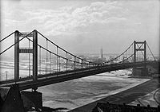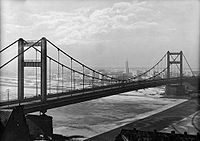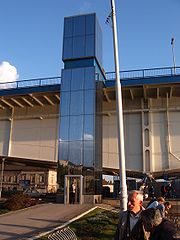
Branko's Bridge
Encyclopedia
Branko's bridge is the second-largest bridge
(after Gazela
) of Belgrade
, Serbia
, connecting the city center with New Belgrade across Sava river
.
 The bridge was built in 1957, replacing the former chain-stayed King Aleksandar I (built by the Société de Construction des Batignolles
The bridge was built in 1957, replacing the former chain-stayed King Aleksandar I (built by the Société de Construction des Batignolles
) bridge that was opened on December 16, 1934 and blown up in 1941. The bridge actually uses lower parts of the former bridge's pylons (decorated by Ivan Meštrović
in Serbo-Byzantium style) as outer constraints for its two secondary spans. It has dual carriageway
with three lane
s in both directions; actually, it consists of two separate constructions in each direction, and the second was finished in 1979. It is 450 m long, made as continuous steel box girder
, with central span
of 261 m and side spans of 81.5 m each. It is crossed by nearly 90,000 vehicles daily, and traffic congestion
s are frequent.
German company MAN is behind the original project of the bridge. Belgrade-based "Mostprojekt" company executed the project of doubling the bridge capacity in the 1970s. Head of the project team was Danilo Dragojević.
 The name of the bridge is unofficial, and seems to owe it to a bizarre chain of events. Its official name during the communist rule was "Brotherhood and unity
The name of the bridge is unofficial, and seems to owe it to a bizarre chain of events. Its official name during the communist rule was "Brotherhood and unity
bridge" (Most bratstva i jedinstva), but that name never caught up: it was called "bridge in Branko's street" (named after Branko Radičević
, Serbian romanticist poet) or "Savski most" (Sava bridge). However, when another writer, Branko Ćopić
, committed a suicide by jumping from the bridge in 1984, the current name started circulating and eventually caught up; it is still not clear after which Branko it was named.
Bridge
A bridge is a structure built to span physical obstacles such as a body of water, valley, or road, for the purpose of providing passage over the obstacle...
(after Gazela
Gazela Bridge
Gazela is the most important bridge in Belgrade, Serbia, across the Sava river. It is a part of the city highway and it lies on European route E75, on the highway passing through the wider city center, connecting Belgrade with Niš to the south, and Novi Sad to the north...
) of Belgrade
Belgrade
Belgrade is the capital and largest city of Serbia. It is located at the confluence of the Sava and Danube rivers, where the Pannonian Plain meets the Balkans. According to official results of Census 2011, the city has a population of 1,639,121. It is one of the 15 largest cities in Europe...
, Serbia
Serbia
Serbia , officially the Republic of Serbia , is a landlocked country located at the crossroads of Central and Southeast Europe, covering the southern part of the Carpathian basin and the central part of the Balkans...
, connecting the city center with New Belgrade across Sava river
Sava River
The Sava is a river in Southeast Europe, a right side tributary of the Danube river at Belgrade. Counting from Zelenci, the source of Sava Dolinka, it is long and drains of surface area. It flows through Slovenia, Croatia, along the northern border of Bosnia and Herzegovina, and through Serbia....
.

Société de Construction des Batignolles
The Société de Construction des Batignolles was a civil engineering company of France created in 1871 as a public limited company from the 1846 limited partnership of Ernest Gouin et Cie....
) bridge that was opened on December 16, 1934 and blown up in 1941. The bridge actually uses lower parts of the former bridge's pylons (decorated by Ivan Meštrović
Ivan Meštrovic
Ivan Meštrović was a Croatian and Yugoslav sculptor and architect born in Vrpolje, Croatia...
in Serbo-Byzantium style) as outer constraints for its two secondary spans. It has dual carriageway
Dual carriageway
A dual carriageway is a class of highway with two carriageways for traffic travelling in opposite directions separated by a central reservation...
with three lane
Lane
A lane is a part of the roadway within a road marked out for use by a single line of vehicles in such a way as to control and guide drivers for the purpose of reducing traffic conflicts. Most public roads have at least two lanes, one for traffic in each direction, separated by Lane markings...
s in both directions; actually, it consists of two separate constructions in each direction, and the second was finished in 1979. It is 450 m long, made as continuous steel box girder
Girder
A girder is a support beam used in construction. Girders often have an I-beam cross section for strength, but may also have a box shape, Z shape or other forms. Girder is the term used to denote the main horizontal support of a structure which supports smaller beams...
, with central span
Span (architecture)
Span is the distance between two intermediate supports for a structure, e.g. a beam or a bridge.A span can be closed by a solid beam or of a rope...
of 261 m and side spans of 81.5 m each. It is crossed by nearly 90,000 vehicles daily, and traffic congestion
Traffic congestion
Traffic congestion is a condition on road networks that occurs as use increases, and is characterized by slower speeds, longer trip times, and increased vehicular queueing. The most common example is the physical use of roads by vehicles. When traffic demand is great enough that the interaction...
s are frequent.
German company MAN is behind the original project of the bridge. Belgrade-based "Mostprojekt" company executed the project of doubling the bridge capacity in the 1970s. Head of the project team was Danilo Dragojević.

Brotherhood and unity
Brotherhood and Unity was a popular slogan of the Communist Party of Yugoslavia that was coined during the Yugoslav People's Liberation War , and which evolved into a guiding principle of Yugoslavia's post-war inter-ethnic policy....
bridge" (Most bratstva i jedinstva), but that name never caught up: it was called "bridge in Branko's street" (named after Branko Radičević
Branko Radicevic
Branko Radičević , an influential Serbian poet, within a short space of time contrived to enhance Serbian literature with several perennially attractive poems.- Biography:...
, Serbian romanticist poet) or "Savski most" (Sava bridge). However, when another writer, Branko Ćopić
Branko Copic
Branko Ćopić was Yugoslav writer. He was an ethnic Serb born in the village of Hašani near Bosanska Krupa. He attended schools in Bihać, Banja Luka, Sarajevo and Karlovac before moving to Belgrade to study philosophy at the University of Belgrade until his graduation in 1940.Upon the uprising in...
, committed a suicide by jumping from the bridge in 1984, the current name started circulating and eventually caught up; it is still not clear after which Branko it was named.
External links
- Fanovi „Stonsa“ opasno zaljuljali Brankov most, BlicBlic (newspaper)Blic is a tabloid daily newspaper in Serbia owned by Ringier AG group from Switzerland.Started in 1996, it has gone through a slight format change during the mid 2000s to include more in-depth coverage, but it is still, as its name aptly suggest, a paper devoted to quick, concise,...
, 17. jul 2007 - http://www.blic.rs/Vesti/Beograd/92810/Policija-nije-dala-da-veceraju-na-Brankovom-mostu

